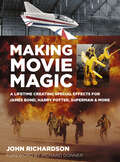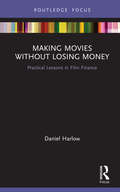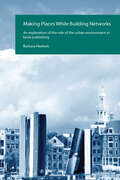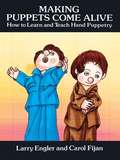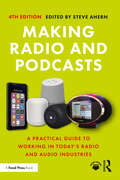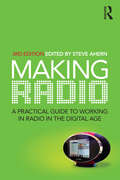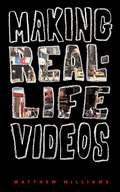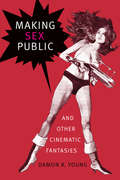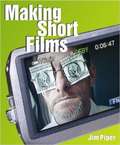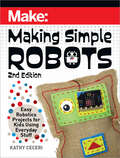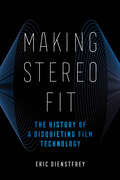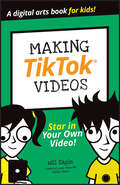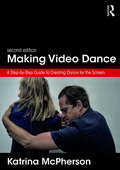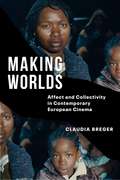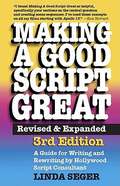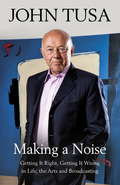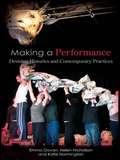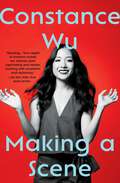- Table View
- List View
Making Movie Magic: A Lifetime Creating Special Effects for James Bond, Harry Potter, Superman and More
by John Richardson Richard Donner‘It made for an easy read and a lot of chuckling. If you didn’t have respect for physical special effects in films before, you will now.’ G. F. Willmetts, SFcrowsnest‘the perfect blend of autobiography and behind-the-scenes storytelling. Making Movie Magic is a magic movie-making book.’ Brian James Smith, From Sweden With Love?JOHN RICHARDSON is an Oscar-winning special effects supervisor and designer, who has been involved in over 100 movies, including nine James Bond adventures, all eight Harry Potter films, Aliens, Superman, A Bridge Too Far, Straw Dogs, The Omen, Cliffhanger, Far and Away, Willow . . . and many, many more. In creating the magic that flows through these films – by creating huge explosions, beheading people, producing futuristic gadgets, making a man fly or breathing life into creatures that amaze and haunt us – Richardson has come to hold a unique place in cinema history.The son of pioneering FX technician Cliff Richardson, he learned his trade at the feet of a master of the craft. With over five decades of adventures under his belt, and a vast photographic collection of unseen pictures, Richardson now lifts the lid on his exciting and fascinating career of making movie magic.
Making Movies
by Sidney LumetSidney Lumet writes about his experiences in the movie industry and the difficulties faced in making films.
Making Movies Without Losing Money: Practical Lessons in Film Finance
by Daniel HarlowThis book is about the practical realities of the film market today and how to make a film while minimizing financial risk. Film is a risky investment and securing that investment is a huge challenge. The best way to get investors is to do everything possible to make the film without losing money. Featuring interviews with film industry veterans - sales agents, producers, distributors, directors, film investors, film authors and accountants - Daniel Harlow explores some of the biggest obstacles to making a commercially successful film and offers best practice advice on making a good film, that will also be a commercial success. The book explores key topics such as smart financing, casting to add value, understanding the film supply chain, the importance of genre, picking the right producer, negotiating pre-sales and much more. By learning how to break even, this book provides invaluable insight into the film industry that will help filmmakers build a real, continuing career. A vital resource for filmmakers serious about sustaining a career in the 21st century film industry.
Making Music in Los Angeles: Transforming the Popular
by Catherine Parsons SmithIn this social history of music in Los Angeles from the 1880s to 1940, Catherine Parsons Smith ventures into an often neglected period to discover that during America's Progressive Era, L.A. was a center for making music long before it became a major metropolis. She describes the thriving music scene over some sixty years, including opera, concert giving and promotion, and the struggles of individuals who pursued music as an ideal, a career, a trade, a business--or all those things at once.
Making Places While Building Networks: An exploration of the role of the urban environment in book publishing (Pallas Proefschriften)
by Barbara HeebelsThe Amsterdam ring of canals is a much beloved location for Dutch book publishers. An exposition of the meaning of this urban environment for publishers adds to the existing knowledge on book publishers and their business locations. It also contributes to our understanding of the role of urban place in cultural production by looking at cultural production from a relatively unexplored angle – that of the cultural intermediary – and by conceptualizing place as a dynamic concept. Publishers function as cultural intermediaries by bringing together the creation of cultural value and the selling of cultural products. An exploration of the meaning of urban place for cultural intermediaries in building reputation and trust in their personal networks with authors, booksellers, colleagues and the press, shows that place is more than geographical proximity and is not a static condition for knowledge spill-overs: it is a process, one that is interdependent on social networks.
Making Puppets Come Alive: How to Learn and Teach Hand Puppetry
by Larry Engler Carol FijanUnlike other performing arts, puppetry is perhaps the only art form in which directing, acting, writing, designing, sculpture, and choreography are combined. In effect, the performer is creating an artistic entertainment that will appeal to audiences of all ages -- in homes, in theaters, and in classrooms.This lucid, easy-to-follow book was specifically conceived to teach beginners how to bring a hand puppet to life and how, with practice, to develop the skills needed to mount an amateur puppet show -- complete with staging, costumes, and special effects. Award-winning puppeteers Larry Engler and Carol Fijan provide ingenious finger, wrist, and arm exercises that are crucial for creating a full working range of puppet motions and emotions. They also cover the elements of good puppet theatrical technique: speech, voice use, and synchronization; stage deportment and interactions; improvisation, dramatic conflict, role characterization, and more.Every detail is clearly explained and beautifully illustrated with photographs, specific chapters being devoted to the use of props, puppet voices and movements, the construction of simple stages and lighting effects, and much more. A splendid addition to the literature on this subject, Making Puppets Come Alive is "the best book on hand puppetry we've seen." -- The Whole Kids Catalog.
Making Radio and Podcasts: A Practical Guide to Working in Today's Radio and Audio Industries
by Steve AhernMaking Radio and Podcasts is a practical guide for anyone who wants to learn how to make successful programmes in the digital era. It examines the key roles in audio and podcasting: announcing, presenting, research, copywriting, producing, marketing and promotions. It also outlines what is involved in creating different types of programmes: news and current affairs, music, talkback, comedy and features, podcasts, as well as legal and regulatory constraints. With contributions from industry experts, the fully updated fourth edition is global in focus and reflects the impact of podcasts and digital radio, including multi-platform delivery, listener databases, social media and online marketing. It also examines how radio stations have reinvented their business models to accommodate the rapid changes in communications and listener expectations. This is the ideal text for undergraduate and postgraduate students taking courses on radio, audio and podcasting, media production and digital media, with broader appeal to professionals and practitioners in the audio industries.
Making Radio: A practical guide to working in radio in the digital age
by Steve Ahern'The distilled wisdom and passion of top practitioners makes this an invaluable guide to making radio in Australia.' - Siobhan McHugh, award-winning radio feature producer and lecturer, University of Wollongong'a very useful hands-on guide to radio production in Australia' - Gail Phillips, Associate Professor of Journalism, Murdoch University'Making Radio has been a core text for all our radio courses since it was written. It covers everything form the basics you need to know when you begin your radio career, to high level skills required for career advancement.' - Kim Becherand, AFTRS Radio DivisionMaking radio programs gets into your blood: it's one of the most stimulating jobs in the world, in a fast-moving industry, at the cutting edge of digital technology.Making Radio is a practical guide for anyone who wants to learn how to make good radio in the era of Radio 2.0. It examines the key roles in radio: announcing, presenting, research, copywriting, producing, marketing and promotions. It also outlines what is involved in creating different types of radio programs: news and current affairs, music, talkback, comedy and WC features, as well as legal and regulatory constraints.With contributions from industry experts, the third edition reflects the impact of digital radio, including multi-platform delivery, listener databases, social media and online marketing. It also examines how radio stations have reinvented their business models to accommodate the rapid changes in communications and listener expectations.
Making Real-Life Videos: Great Projects For The Classroom And Home
by Matthew WilliamsGetting a good home video is hit-or-miss. Plenty of times, they're dark and fuzzy and Aunt Myrna is washed out and Junior . . . do his eyes always look like that? This unique, accessible guide for living room and classroom provides step-by-step instructions with ten "assignments," plus ideas and information on everything from basic concepts to planning, shooting, and editing, Making Real-Life Videos frees the talents of anyone who has ever wanted to direct. Perfect for anyone with a video camera Step-by-step "assignments" plus tips that will improve results at every level
Making Sex Public and Other Cinematic Fantasies (Theory Q)
by Damon R. YoungBeginning in the late 1950s, representations of and narratives about sex proliferated on French and U.S. movie screens. Cinema began to display forms of sexuality that were no longer strictly associated with domesticity nor limited to heterosexual relations between loving couples. Women’s bodies and queer sexualities became intensely charged figures of political contestation, aspiration, and allegory, central to new ways of imagining sexuality and to new liberal understandings of individual freedom and social responsibility. In Making Sex Public Damon R. Young tracks the emergence of two conflicting narratives: on the one hand, a new model of sex as harmoniously integrated into civic existence; on the other, an idea of women’s and queer sexuality as corrosive to the very fabric of social life. Taking a transatlantic perspective from the late '50s through the present, from And God Created Woman and Barbarella to Cruising and Shortbus, Young argues that cinema participated in the transformation of the sexual subject while showing how women and queers were both agents and objects of that transformation.
Making Short Films
by Jim PiperAccompanying DVD of thirty short films offers an instructive mini film festival Shows beginners how to make meaningful films without fancy equipment Great for film students and independent filmmakers Want to make an art film, a documentary, a video biography? Here’s how to create real movies using consumer digital video format-without spending a lot of money or time. Author Jim Piper has taught filmmaking for more than thirty years-and along with his technical expertise, he brings entertaining anecdotes and great examples. His descriptions of more than one hundred student films, illustrated with three hundred stills, offer inspiration for beginners, and the accompanying DVD showcases thirty examples that comprise an intriguing and instructive mini film festival.Allworth Press, an imprint of Skyhorse Publishing, publishes a broad range of books on the visual and performing arts, with emphasis on the business of art. Our titles cover subjects such as graphic design, theater, branding, fine art, photography, interior design, writing, acting, film, how to start careers, business and legal forms, business practices, and more. While we don't aspire to publish a New York Times bestseller or a national bestseller, we are deeply committed to quality books that help creative professionals succeed and thrive. We often publish in areas overlooked by other publishers and welcome the author whose expertise can help our audience of readers.
Making Simple Robots: Easy Robotics Projects for Kids Using Everyday Stuff
by Kathy CeceriMaking Simple Robots is based on the idea that anybody can build a robot! That includes kids, educators, parents, and anyone who didn't make it to engineering school. If you can cut, fold, and tape a piece of paper to make a tube or a box, you can build a no-tech robotic part. In fact, many of the models in this book are based upon real-life prototypes -- working models created in research labs and companies. What's more, if you can use the apps on your smartphone, you can quickly learn to tell robots what to do using free, online, beginner-level software like MIT's Scratch and Microsoft MakeCode.The projects in this book which teach you about electric circuits by making jumping origami frogs with eyes that light up when you get them ready to hop. You'll practice designing all-terrain robot wheel-legs with free, online Tinkercad software, and you'll create files ready for 3D printing. You'll also learn to sew -- and code -- a cyborg rag doll with a blinking electronic "eye."Each project includes step-by-step directions and clear illustrations and photographs. Along the way, you'll learn about the real research behind the DIY version, find shortcuts for making projects easier when needed, and get suggestions for adding to the challenge as your skill set grows.
Making Stereo Fit: The History of a Disquieting Film Technology (California Studies in Music, Sound, and Media #6)
by Eric DienstfreySurround sound is often mistaken as a relatively new phenomenon in cinemas, one that emerged in the 1970s with the arrival of Dolby. Making Stereo Fit reveals that, in fact, filmmakers have been creating stereo and surround-sound effects for nearly a century, since the advent of talking pictures, and argues that their endurance owes primarily to the longstanding battles between stereo and mono technologies. Throughout the book, Eric Dienstfrey analyzes newly discovered archival materials and myriad stereo releases, from Hell’s Angels (1930) to Get Out (2017), to show how Hollywood’s financial dependence on mono prevented filmmakers from seeing surround sound’s full aesthetic potential. Though studios initially explored stereo’s unique capabilities, Dienstfrey details how filmmakers eventually codified a conservative set of surround-sound techniques that prevail today, despite the arrival of more immersive formats.
Making TikTok Videos (Dummies Junior)
by Andrew Cooper Claire Cohen Will Eagle Hannah Budke Jordan Elijah Michael Andrew PanturescuCreate videos using the tricks of TikTok stars! Making TikTok Videos reveals the secrets that TikTok celebs and influencers use to make the videos that everyone’s watching. Hilarious clips, the latest dances, instruction videos—whatever you want to do, make sure it shows off the latest TikTok styles. This book shows you how to use whatever you have on hand to record, edit, and upload TikToks. Add music and text, get creative, and start sharing your finished products. With this guide, you’ll get easy instructions on how to make videos that people remember. You also get some tips on how to bring viewers to your account. Use your mobile device to shoot videos with top-notch sound Learn the editing tricks TikTok pros use to create a finished video Set up your TikTok account and set your privacy Keep up with the latest TikTok video stylesWritten especially for the 10-14 age group interested in creating their first TikTok videos, this Dummies Jr. title will help you get plugged into the TikTok universe.
Making Tootsie: A Film Study with Dustin Hoffman and Sydney Pollack (Shooting Script)
by Susan Dworkin“A perceptive and provocative work.”—Los Angeles Times“A stunning job of research, observation and reporting.”—Larry Gelbart, co-writer of Tootsie and writer on TV’s “M*A*S*H*”“This fluid, marvelously detailed book goes a long way toward explaining why Tootsie has already achieved a reputation as a classic film comedy.” —PeopleMaking Tootsie is back, three decades after the creation of the blockbuster Hollywood motion picture that the American Film Institute rated as #2 on its list of the 100 Best Comedies of All Time (second only to Some Like it Hot). Playwright, author, and Ms. magazine contributing writer Susan Dworkin was granted unprecedented access to the film set, the cast, and the crew during the filming and through post-production of the 1982 classic, and her riveting, detailed chronicle offers a fascinating window into the art of movie making—as well as painting indelible portraits of the two main men who made Tootsie happen: director Sidney Pollack and star Dustin Hoffman. No movie buff, film historian, student, or fan will want to miss Making Tootsie.
Making Video Dance: A Step-by-Step Guide to Creating Dance for the Screen (2nd ed)
by Katrina McPhersonMaking Video Dance: A Step-by-Step Guide to Creating Dance for the Screen is the first workbook to follow the entire process of video dance production: from having an idea, through to choreographing for the screen, filming and editing, and distribution. In doing so, it explores and analyses the creative, practical, technical, and aesthetic issues that arise when making screen dance. This rigorously revised edition brings the book fully up to date from a technical and aesthetic point of view, and includes: An extended exploration of improvisation in the video dance-making process New writing about filming in the landscape Additional writing on developing a practice and working with scores and manifestos Updated information about camera use, including filming with mobile phones A step-by-step guide to digital non-linear editing of screen dance Ideas for distribution in the 21st century Insights into Katrina’s own screen dance practice, with reference to specific works that she has directed and which are available to view online New and revised practical exercises New illustrations specially drawn for this edition
Making Worlds: Affect and Collectivity in Contemporary European Cinema
by Claudia BregerThe twenty-first century has witnessed a resurgence of economic inequality, racial exclusion, and political hatred, causing questions of collective identity and belonging to assume new urgency. In Making Worlds, Claudia Breger argues that contemporary European cinema provides ways of thinking about and feeling collectivity that can challenge these political trends.Breger offers nuanced readings of major contemporary films such as Michael Haneke’s The White Ribbon, Alejandro González Iñárritu’s Biutiful, Fatih Akın’s The Edge of Heaven, Asghar Farhadi’s A Separation, and Aki Kaurismäki’s refugee trilogy, as well as works by Jean-Luc Godard and Rainer Werner Fassbinder. Through a new model of cinematic worldmaking, Breger examines the ways in which these works produce unexpected and destabilizing affects that invite viewers to imagine new connections among individuals or groups. These films and their depictions of refugees, immigrants, and communities do not simply counter dominant political imaginaries of hate and fear with calls for empathy or solidarity. Instead, they produce layered sensibilities that offer the potential for greater openness to others’ present, past, and future claims. Drawing on the work of Latour, Deleuze, and Rancière, Breger engages questions of genre and realism along with the legacies of cinematic modernism. Offering a rich account of contemporary film, Making Worlds theorizes the cinematic creation of imaginative spaces in order to find new ways of responding to political hatred.
Making Your Film for Less Outside the U.S.
by Mark DewayneAt last, here is a definitive step-by-step guide that explains everything needed to successfully produce and distribute films overseas. Following the advice found here, filmmakers will learn to make films in foreign countries that cost less money and allow the artists greater creative control. Chapters include: scheduling and budgeting, foreign censors, accommodations and office rental, scams to avoid, foreign film festivals, working with digital equipment, and more. An in-depth study compares production costs between the U.S. and Canada, Mexico, England, France, Bulgaria, South Africa, the Philippine Islands, Hong Kong, Australia, and Thailand. The author offers a sample budget for an overseas film shoot and offers tips for cutting costs on transportation, location fees, wardrobe, hair and makeup, catering, and equipment. Interviews with nine entertainment industry veterans reveal marketing and distribution trends in the American film market for foreign-made projects. And special chapters are included on writing for overseas production and on new technology as it relates to digital film and video provide essential insight to today's filmmaker. Directors, producers, screenwriters, and actors will learn how to turn their film projects from a dream to reality.
Making a Good Script Great (3rd edition)
by Linda SegerThis book takes you through the whole screenwriting process--from initial concept through final rewrite--providing specific methods that will help you craft tighter, stronger, and more saleable scripts.
Making a Noise: Getting It Right, Getting It Wrong In Life, Arts And Broadcasting
by John TusaIn almost sixty years of professional life, John Tusa has fought for and sometimes against the major arts and political institutions in the country. A distinguished journalist, broadcaster and leader of arts organisations, he has stood up publicly for the independence of the BBC, the need for public funding of the arts and for the integrity of universities. He has made enemies in the process. From the battles to create the ground-breaking Newsnight in 1979, to six years of defending the BBC World Service from political interference, Tusa's account is etched with candour. His account of two years of internecine warfare at the top of the BBC under the Chairman, 'Dukey' Hussey will go down as a major contribution to BBC history. His recollections of a hilarious and petty-minded few months as head of a Cambridge college will be read as a case study of the absurdities of academic life; while running the rejected and maligned Barbican Centre, Tusa led its recovery into the major cultural centre that it is today.Often based on personal diaries, Making a Noise is a fearless and entertaining memoir of life at the top of the arts and broadcasting.
Making a Noise: Getting It Right, Getting It Wrong in Life, Arts and Broadcasting
by Sir John TusaJohn Tusa is a distinguished journalist, broadcaster and leader of arts organisations, best remembered for his times at the BBC, including creating Newsnight.Tusa's memoir is etched with candour. His account of two years of internecine warfare at the top of the BBC under the Chairman, 'Dukey' Hussey will go down as a major contribution to BBC history. His recollections of a hilarious and petty-minded few months as head of a Cambridge college will be read as a case study of the absurdities of academic life; while running the rejected and maligned Barbican Centre, Tusa led its recovery into the major cultural centre that it is today.
Making a Performance: Devising Histories and Contemporary Practices
by Katie Normington Helen Nicholson Emma GovanMaking a Performance traces innovations in devised performance from early theatrical experiments in the twentieth-century to the radical performances of the twenty-first century. This introduction to the theory, history and practice of devised performance explores how performance-makers have built on the experimental aesthetic traditions of the past. It looks to companies as diverse as Australia's Legs on the Wall, Britain's Forced Entertainment and the USA-based Goat Island to show how contemporary practitioners challenge orthodoxies to develop new theatrical languages. Designed to be accessible to both scholars and practitioners, this study offers clear, practical examples of concepts and ideas that have shaped some of the most vibrant and experimental practices in contemporary performance.
Making a Scene
by Constance WuNamed a Most Anticipated Book by Time and Associated Press! From actor Constance Wu, a powerful and poignant memoir-in-essays.Growing up in the friendly suburbs of Richmond, Virginia, Constance Wu was often scolded for having big feelings or strong reactions. &“Good girls don&’t make scenes,&” people warned her. And while she spent most of her childhood suppressing her bold, emotional nature, she found an early outlet in local community theater—it was the one place where big feelings were okay—were good, even. Acting became her refuge, her touchstone, and eventually her vocation. At eighteen she moved to New York, where she&’d spend the next ten years of her life auditioning, waiting tables, and struggling to make rent before her two big breaks: the TV sitcom Fresh Off the Boat and the hit film Crazy Rich Asians. Through raw and relatable essays, Constance shares private memories of childhood, young love and heartbreak, sexual assault and harassment, and how she &“made it&” in Hollywood. Her stories offer a behind-the-scenes look at being Asian American in the entertainment industry and the continuing evolution of her identity and influence in the public eye. Making a Scene is an intimate portrait of pressures and pleasures of existing in today&’s world.
